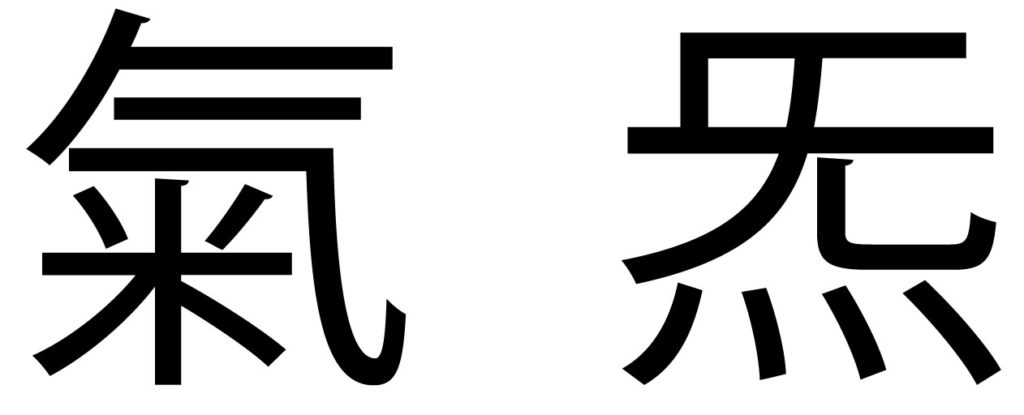
To understand Qi, is to understand the mystery of life.
Throughout history cultures around the world have talked about some kind of vital life force that that flows through all living things to animate them. In India they called this ‘prana’, in the Pacific Islands it was referred to as ‘mana’, in ancient Greece ‘pnuema’, and in Western philosophy they had concepts of energia, or elan vital. Qi is the Chinese version of this concept which is common to all cultures, an attempt to describe the very stuff of life itself.
The Chinese Characters for Qi
Perhaps looking at the characters used to write ‘Qi’ in Chinese may give us some further insight into their specific view of what this vital energy is. Chinese characters are a type of pictogram – small abstract drawings, that are combined together in different ways to depict the concepts related to the words that they represent. As such the characters sometimes contain rich meaning when we choose to look into them deeply.
The most common character for qi is this 氣. It is made up of two parts or pictograms. 气 which represents air, and 米 which represents rice. So the combined character 氣 represents the steam coming off rice. It is clear that they are pointing to something insubstantial and perhaps even almost intangible, but that we see clearly in the mundane things of everyday life. This character 氣 is often simplified to just 气 for common usage. The surface meaning of this part of the character has led some people to believe that qi is just air or breathing – but as we will see later, this falls far short of its true meaning. For now we have another character to examine.
炁 is a more ancient and less commonly used character for qi. The place where it is particularly found is in old Daoist texts and talismans. It has essentially the same surface meaning and pronunciation as 氣, so they clearly chose to use this character instead because of the symbolism embedded within it. Again this character is made up of two parts: 旡 which means nothing, and 火 which represents fire (火 is rendered to look like this 灬 when used as a radical and combined with other characters). So the combined character 炁 means “no fire”, the fire, or in other words ‘energy’ that comes from nowhere.
So we have two characters for the same word, with quite different symbolism behind them. One is eminently practical – energy we can see and experience in practical terms as represented by cooking rice, and the other rather more philosophical, describing an energy which we cannot determine the source of – it comes from nothing. I think this is where much of the mystery and misunderstandings about qi comes from. As a concept, at a simple level it is extremely practical, while also being deeply philosophical at the same time. If we can embrace both of these aspects of the meaning of qi, we will come much closer to being able to truly comprehend it and apply that understanding to our lives.
Contextual Application of the Concept of Qi
The Chinese talk about qi as being the living force running through the cosmos, the movement of the galaxies, the sun, the moon, and the weather, while also defining very specific kinds of qi like the energy we get from eating food: 谷氣 which is distinguished from the energy we get from breathing: 空氣. So clearly the specifics of what ‘Qi’ means in practical terms depends very much on the context in which it is used. If we can embrace this dichotomy, of qi being a way of describing the very flow of life while also having specific practical manifestations, then it becomes a very useful concept for us to apply to our lives. We can accept that what we are talking about when we describe the qi or the energy in a lighting storm, or in a tree, or in a human body, are the same thing in the context that the energy gives life to those things, but takes sometimes very different forms within them. Because it has taken a different form, does not mean that we are no longer talking about qi. We can then become quite specific about each of these different types of qi or energy, while recognizing that they are part of a greater whole that flows throughout the universe. We can recognize that connection, and start to see the patterns, the way that one form of energy is transformed into another, and each kind of energy is truly connected and part of a greater pattern and cycle.
The energy of the weather affects the growing of crops. The growing of crops affects our access to food, and therefore in many very real ways our vitality as a living organism as well as our behaviour and activities. Our behaviour and activities as humans then affects the weather… This is a greatly simplified example, there are many many other interconnections as well, but we can start to see the connectedness between all of the different manifestations of energy.
For the sake of our discussion, for the rest of this article we will look primarily at the qi within human beings – as this is of close and personal interest to each of us, and which we will have direct and practical application for. Exploring those other types of energy and cycles can be extremely fascinating as well, but will have to wait for another article.
Qi Is What Makes Us Alive
Remembering that qi is living energy, one way to think about what qi is, is to consider – what kind of energy does it take to be alive?
Think for a moment. What kind of energy do you need inside you to make you alive?
Heat
Well… we need to have heat inside us to be alive. That is why we sometimes refer to someone who is alive as a ‘warm body’, because without life the body loses its heat. This heat is created through the living activity of each of the cells in the body and is necessary for the vast range of chemical reactions that occur moment to moment within us.
Chemical Energy
And that is another type of energy or qi we must have inside us to be alive. Chemical energy. This aligns well with some of the classical Chinese categorizations of qi – food and air. We use the nutrients found in food and the gases from air to produce the different substances and energy that we need within our body to live.
Movement
Our body needs to be constantly moving to be alive. Even when we are still externally, to be alive the movement must continue internally. Those chemicals from our food and air need to be moved to where they are needed, and wastes removed. Blood and other fluids are constantly circulating. The organs of the body alternate between contracting and releasing to power this movement. One of the things most commonly used to check for life is a heart beat… the internal movement of an organ that affects the movement of substances through the rest of the body.
Electricity
One aspect of a healthy heart is that is has a strong rhythmic pattern of electrical energy. Every part of our body relies on electricity as part of what makes us alive. Electrical currents run through our nervous system, our bones, and every cell of our body. Without it we simply could not function. And wherever there is an electrical current, a magnetic field also forms… adding another layer to our understanding of our living energy.
A Simple Practical Definition of Qi
To define qi within a human body, it really can be as simple as asking what kinds of energy need to be present for there to be life, but you may have noticed that there is something essentially important missing from the types of energy we have discussed above.
You can take a body and heat it up to the right temperature, you can make sure that all of the right chemicals are present and moving properly inside it. You can run electrical currents through it as well, but even with all these types of energy combined it still may not be alive. To be alive there needs to be something extra, something that organizes and directs the activity of all of the different kinds of energy. And I think this is what makes it mysterious. What is it that gives life? This is what takes qi beyond simplistic scientific definitions into another realm of understanding.
When something is alive, it is not just passive to the energy within and around it, but rather it responds to it and directs it, and even converts it into different forms. As a simple example, if I were to rub my arm – this is some physical pressure and movement from the outside, a kind of kinetic energy. Without life, not much would happen, but with life this sets into motion a whole chain of responses which activates the living energy within. The pressure from the rubbing stimulates electrical activity in my nerves, which activate the cells to become more active. As the cells become more active, they generate heat from their activity. They also use more oxygen and other substances in the chemical reactions that occur within them, so the body responds by increasing the rate of bloodflow to the area and also the circulation of other fluids to remove wastes. And it is not just the immediate area that is affected – because of the requirement for more bloodflow, the heart becomes more active (even if only to a small degree because it is a relatively small stimulus). Other organs also become more active releasing nutrients and hormones, and filtering waste. The signal from the nerves travels all the way to the brain to be processed, which may lead to signals being sent to many other parts of the body to respond to the stimulation that is occurring. If we compare this to what would happen when we apply this stimulus to a non-living thing, the difference is vast. In the non-living thing there may be some localized movement caused by the pressure applied, and maybe some heat from friction – but that would be all, there would be no ongoing symphony of activity of energy of many types working in harmony together.
I demonstrate this principle and talk about it a little more in the video below.
Qi is Not Just One Thing
We have seen already how the different types of energy in different things within the universe, such as the energy of the movement of the stars, the energy of the weather, the energy in plants, and the energy of people are all quite clearly different types of qi, but still part of a greater whole. They each take different forms according to their use and need – but are still qi.
The same is true within a human being. There is not just one type of qi, but rather the qi takes different forms, and combines in different ways according to its purpose within the being. The basic components we have discussed so far of heat, movement, chemical energy, electricity and magnetism will usually be present to greater or lesser degrees, but this does not mean that qi is any one of these things by itself, or that it is limited to just these things. There may be other components, other parts of living energy that we do not understand yet, that form part of living energy as well, and we just don’t know how to identify those components yet.
And this is part of the beauty of the concept of qi. It is not limited to any one specific measurable factor, but rather encompasses all of the energy that makes up life.
This aspect of qi has been the cause of much frustration and confusion amongst researchers, as it defies narrow definition. But still, many have tried to do this, some seeking to identify and measure some previously unknown construct that they can point to and say that they have scientifically discovered and proven the existence of qi! Others have resorted to massive oversimplification so that they can come up with something that they can say is a definitive measurement of qi. One common oversimplification is to point to bioelectricity as the true essence of qi. Clearly bioelectricity forms part of what we term ‘qi’, but if we restrict our study of qi to just this one component we miss all of the other parts that make it up, and we also potentially miss what is truly unique about it – that it is living and responsive.
Working with and measuring each individual part of our living energy has value and provides us with more insight into what makes up our living energy. There have been experiments measuring things such as infrared radiation, vibrations in the form of soundwaves, bioelectricity (as already mentioned), and even the emission of certain types of charged particles. But no one of these things is definitively a measurement of ‘qi’ on its own, rather they are measurements of individual components of something much more complex.
The Value of Qi as a Concept
Part of the value of qi as a concept, is that it helps us to move from a narrow and restrictive view of the world, to a more expansive and connected one. If we take the example of human health – we might want to improve the health of a certain part of the body. If we take a restrictive view of the function of the body, we might focus on just the bioelectrical functions in that area. This will be useful in many cases, but it also runs the risk of missing the mark. You might do all sorts of things to strengthen and balance the bioelectricity in that part of the body but still not improve the health of that area if there is something else that actually needs addressing. When we consider ‘qi’ as a whole, we include all of the many parts of living energy together in our awareness. We do not neglect the importance of bioelectricity, but we also recognize the other things that are important to the living energy as well.
This wholistic view helps us to work towards what we actually want, rather than towards a proxy of what we want, which may not actually lead to the results that we seek.
In practices such as qigong we tune into the presence and movement of living energy or qi within and around us. We seek to sense where it is flowing freely, where it may be blocked or stuck, where there is too much or too little energy, and the what the qualities of that energy are and if they suit our current needs. By tuning into this energy, we are then able to make changes to bring it into a state of better balance and health. In very practical terms this means things like aligning the joints so that there is not too much pressure on the nerves and they can function freely. Adjusting the tensions in muscles to allow them to release wastes and support a healthy posture. Breathing more deeply to fully oxygenate the blood, increasing bloodflow to parts of the body that need it, and many more incredibly subtle functions of the body necessary for full health and wellbeing.
We do this by focusing on the qi as whole. It would be simply too difficult to identify, become aware of, and then influence each of the bodies many functions individually. But by focusing on the ‘qi’ as a whole, the sum total of all these functions combined, we are able to make the subtle adjustments we need to make our energy, and therefore our body, fully healthy.
Through the lens of ‘qi’, this awareness of the connection between things can extend out far beyond just our physical body. We can become aware of the effect of emotions, patterns of behaviour, interactions with other people, and even our environment, on our life and our health. We can start to be aware of the overall ‘qi’ within interactions, and change and adjust to bring the health and harmony that we seek.
Skeptics, Mystics and Reconciling Dichotomies
When it comes to qi, there are many skeptics, and also many mystics. The skeptics want to completely discount the existence and value of the concept of qi because there is no one single thing that can be pointed to as a measurement of it. The mystics on the other hand do not want to accept the very practical and useful ways of working with qi and even measuring components of it. They are always seeking something magical that goes beyond ordinary experience.
I believe that both of these positions can be reconciled by considering the two different Chinese characters used for representing qi. One is extremely practical and mundane – the steam coming from rice. The other is much deeper – pointing to an energy coming from nowhere, the beginnings of the universe. To repeat the opening statement of this article, to understand qi is to understand the mysteries of life. There are many practicalities within life that we can and should measure and work with in definitive terms, but also many other aspects of life that require a broader and more philosophical perspective to comprehend.
Chinese philosophy is full of such dichotomies, and on a surface level they can initially seem confusing or contradictory, but a deeper investigation helps to make clear that what they are simply doing is providing a true holistic and non-restrictive understanding of a concept. They are showing both sides of the coin at the same time.
Conclusion
I hope that you have enjoyed this brief overview of what qi is. It is a vast topic with many areas to explore and understand, but I hope that this has given you a good foundation to start or complement your understanding of this concept.
I believe that one of the best ways to gain a deeper understanding of qi is through experience, and one of the best ways to gain this experience is through qigong practice where we intentionally focus on our energy and the energy around us, to become aware of it and work with it. Long White Cloud Qigong offers a variety of different courses on qigong that go into both the theory and practice of this fascinating art. You can check out our online courses here, and you can also find information about upcoming retreats and workshops here.
You might also want to subscribe to our mailing list below to stay informed when new articles like this one are published.






1 Comment. Leave new
Thank you for this very well structured answer to what Qi is, very useful.